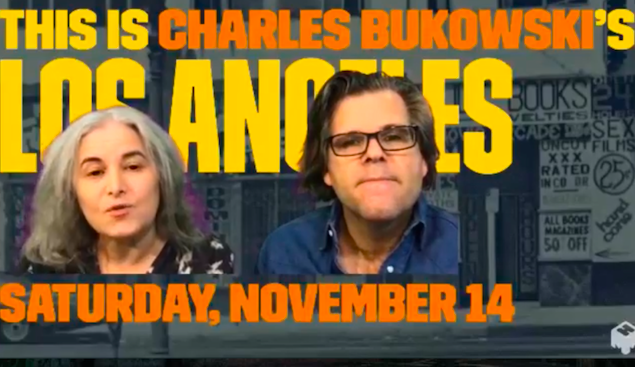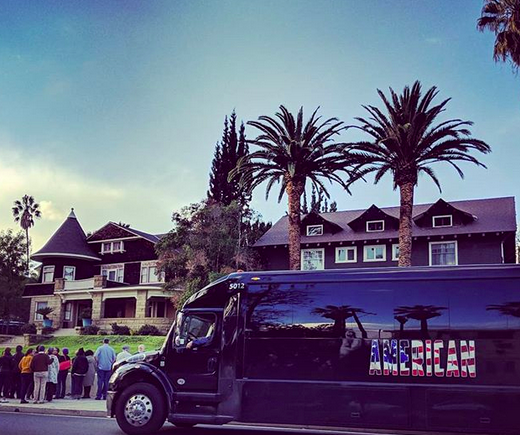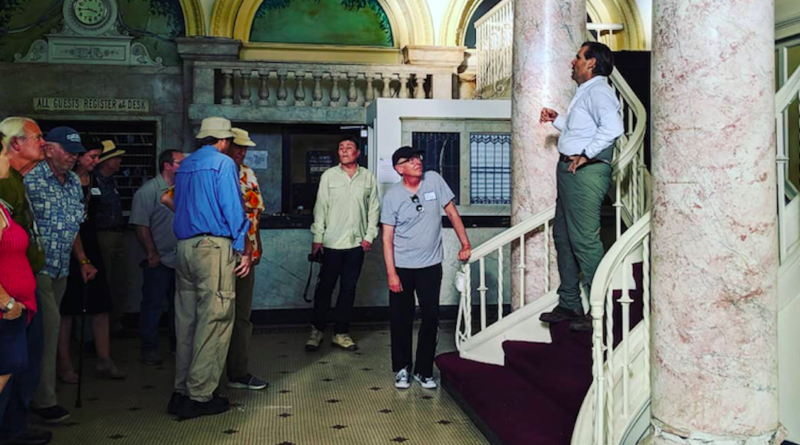INTERVIEW: Esotouric goes into the secret heart of L.A.’s past
Photo: Richard Schave leads a tour group in the King Edward Hotel lobby. Photo courtesy of Esotouric / Provided with permission.
In the pre-pandemic days before COVID-19 became a household name, Kim Cooper and Richard Schave had their Saturdays always booked. That was the day of the week when they would join with 50-plus members of the public and enjoy a bus ride to several Los Angeles neighborhoods.
Cooper and Schave are the creative forces behind Esotouric, an original tour company that promises ticket buyers a look into the “secret heart” of the California city and its environs. Over their many years of successful touring, the couple have developed and deployed L.A.-based tours based around true crime, local culture and important literary figures. One look at their offerings on the big bus, and audience members will understand their unique perspective: “The Real Black Dahlia” (their most popular tour), “Hotel Horrors & Main Street Vice,” “Pasadena Confidential,” “The Lowdown on Downtown” and “John Fante: Dreams From Bunker Hill.”
But in March 2020 — as the story goes — Cooper and Schave found their beloved tour company grind to a halt. Like the rest of the world, Esotouric had to indefinitely postpone its tours, and now they have kept the bus parked for more than a calendar year.
But don’t count out Esotouric. The couple put on their thinking hats — no doubt relying on their unparalleled knowledge of Los Angeles and their educational lessons learned at University of California, Santa Cruz — and overhauled their website and launched a series of weekly webinars. They may not be able to meet with their tour members in person — tour members that they like to call their extended family — but they have built an impressive online community in a few short months. Their weekly offerings have wonderfully entrancing titles, much like their tours: “The Crimes and Oddities of L.A.’s Sunset Boulevard” is scheduled for April 10, while “Los Angeles Underground: Sleuthing Tunnels Lost & Found” was a highlight this past October.
“We’re really happy that we’re still doing what we do, even in these strange circumstances,” Cooper said in a recent phone interview. “We resisted for a long time doing virtual events. We really felt like the whole point of what we do is getting people together in groups to go out into the city, and we can’t do it. And here we are. We’re finding new ways to create a community.”
Schave admitted that redeveloping Esotouric’s website was a project that was perpetually on his to-do list. He said, with a laugh, that he was about two years behind on the project, but the halting of their Saturday bus tours gave him the time to refocus on their virtual offerings. “Once the world went into lockdown in March, it still took months and months and months of work to get the website rebuilt on a development server until we were like, ‘OK, yeah, that actually looks relatively good. Yeah, I’m happy with that,’” Schave said. “And so once we got to that in July, we started very quickly toward webinars.”
Cooper and Schave know a thing or two about web platforms and web content —which is the understatement of the year. Under their “Dig Deeper” tab on the website, one can appreciate the many blogs and entries they have offered the public over the past 10-plus years. There the was the original 1947project, which looks at post-war Angelenos. Then came On Bunker Hill and In SRO Land. There have also been forensic science seminars, the founding of the Los Angeles Visionaries Association (LAVA) and a YouTube channel.
But their bread and butter were the Saturday tours in a bus that held more than 50 people. These tours allowed them not only to tell stories of the “secret” Los Angeles, but also have attendees engage with different communities and neighborhoods, often the ones not included in typical tourist fare. (Note to readers: Cooper and Schave don’t scope out the homes of today’s celebrities.)
“Our calendar is such that we cycle through different tours at different times of the year, and it happened that we had a big tour about the new Chinatown of the San Gabriel Valley that was scheduled in February [of 2020],” Cooper said. “So because the Chinese-American community and the Taiwanese community was very conscious of what’s going on back in the home countries, there was a lot more awareness of COVID in the San Gabriel Valley then anywhere else in L.A., and because we’d always head out and see the people that we’re going to be visiting on tours ahead of time — get some tea, get some dumplings — we were extremely aware of this. So we had this really interesting experience of meeting the people who were expecting us to bring a group in February, and they were asking, ‘Are you still coming?’ Which was really a surprise for us to hear. Of course, we were still coming, but we became very concerned about public health issues.”
Ahead of many other cultural institutions, Esotouric decided to close up shop March 11, 2020. That was before the state, city or county ordered them to do so. Cooper said that she and Schave care about their tour company’s ticket buyers — many of them being repeat customers and local L.A. residents.
“Unlike a lot of tour companies, our audience is mostly local [and] a lot of repeat customers, and they’re on our mailing list,” Cooper said. “And they’re kind of like family, and I was seeing chatter on social media that people weren’t taking the pandemic very seriously and didn’t really think that they necessarily needed to be careful. And I thought I want to be careful, and I want to help our people understand that this is serious. And they need to look after themselves and their health, and take this seriously.”
Little did they know at the time that Los Angeles would have one of the toughest years on record. The city, beloved by locals and visitors alike, became one of the country’s the world’s hotspots for COVID-19, and they are still struggling with the number of infections and deaths.
“We talked for a while what we were going to do,” Cooper remembered. “We said, ‘If we cancel our tours, it’s going to make people understand that this is a big deal, and they’re going to think about what we have to say.’ So we sent out a newsletter that said, ‘If you have a ticket for a tour through June, these tours are postponed, and you can have credit if you want it. Or we can let you know when we’re going to redo this.’ So this is something that we chose to do, and I think it was the right thing to do. And within a week, everything was shut down, and we stayed shut down because it became illegal. … So, we hear all the time from people who are asking, ‘Well, when are you going to be doing this again?’ We just don’t know.”
This “family” of repeat customers started to reach out to Cooper and Schave about their plans for the future. A common thread emerged: Hey, other companies have gone virtual with webinar-style presentations, why not Esotouric? Schave found the software that seemed to be the right fit, and now they are back at it again and have been going strong since fall 2020. Every Saturday, at the exact time when they would normally be heading out on the bus, the two offer their historical insights to a virtual audience from around the world — no doubt many repeat customers amongst the crowd.
“It became obvious really quickly it was going to be very fun for us to have an opportunity to sit down on Saturday at our traditional tour time,” Cooper said. “A webinar isn’t quite as long as a bus tour, which is usually four hours, but it’s the same sort of emotional space where it’s noon on Saturday, all aboard, and we’re going to take you into the past, have some fun and learn some things. So that’s what we’re doing every Saturday. We’ve been doing it since the end of September.”
Schave said the webinars, almost immediately, were a resounding success. There has never been a weekly presentation after which they questioned the decision to go virtual, and, as Cooper said, they started with a bang: a webinar on the historic Bradbury building, which is still available on demand.
“We’re really blessed that we spent 14 years building our brand, so when we decided to start giving webinars, we came out strong,” Schave said. “And we’ve been going strong, and we’ve never, ever wavered in our interest and passion to giving webinars. And we’re going to keep giving them when the lights go on again. We will keep giving webinars.”
And don’t worry, the in-person tours will come around again at a future date. Esotouric still has many places in the “secret heart” of Los Angeles to explore, and now, they have even more people who know their brand of unique tourism. Cooper said each webinar pulls in more people than a single bus could hold, and the chat feature lights up during the weekly discussion.
“On the tour bus, we were always encouraging people to save their questions for the snack break and not chatter because it’s very annoying when narratives are happening, and we’re moving, and we’re showing buildings from the window,” she said. “You can’t have people talking in the back, or it ruins the experience for everyone else. But on the webinars, people very much wanted to have a chance to communicate among themselves and with us while it was happening, so the chat has become a big part of it for the people who watch it live. It becomes available as a video almost immediately, and then it’s on demand. So people who participate live get this sidebar where everybody has their own insights, and they can also ask questions at the end. And so that’s part of the community-building aspect, and I love it. I love seeing familiar faces, even if they’re just names and they’re typing. It’s good to know that they’re still out there, and they’re OK because we miss all of our gentle riders, as we call them.”
How Esotouric became a company has a history that is very much tied to Cooper and Schave’s personal interests. Essentially, they give bus tours (pre-pandemic) and webinars (during the pandemic) because people have asked for them over the years. Cooper was blogging for the 1947project with Nathan Marsak (author of the new book Bunker Hill, Los Angeles) and other authors. The blog emerged because of a book project Cooper was thinking about that involved the 1940s, Los Angeles and using true crime as a lens to explore cultural history.
“The blog got so popular so fast — it was just the right time for it — that people started asking for tours of the locations we were writing about, and I had actually once rented a minivan with some friends in a group called the Cacophony Society, many decades ago now,” Cooper said. “And we had just given an impromptu true crime tour for our own amusement. The people who booked the bus, there were 20 of us, and we just split up telling stories. So I knew that this was something you could do in the city and that it was fun, and so we just chartered a bus for the day and put the word out on the blog and realized immediately that not only was there an audience for it, but it was a really interesting way of exploring the city, telling stories, finding things that were interesting enough to us to keep our imaginations sparked.”
Esotouric formally was launched in 2007, and it has been Saturday engagements ever since. The money that was brought in helped fuel Cooper and Schave’s other obsessions: namely historic research and preservation.
“Kim and I both studied architecture at UC, Santa Cruz in the late-1980s,” Schave said. “And while that was happening, one of my good friends was studying with Bob Winter, co-author of [An Architectural Guidebook to Los Angeles] along with Kim’s graduate adviser, David Gebhard. And Bob Winter … famously had his California Architecture class, which he gave once a year to a packed room, and once a month for the class he would rent a bus on a Friday afternoon, a coach-class bus and drive around and look at buildings. … So I used to come down and stay with my friend who was studying with Bob and get on the bus back when Kim and I were in college together and hated each other, staying with this other famous English art historian, so really the notion of seeing Los Angeles by bus goes back a long way with both of us.”
That whole hating each other and then falling for each other is nicely detailed on their website. That personal charm is another added touch to Esotouric’s offerings. They cover historic topics and grim stories, all with a devoted spotlight and witty repartee. Behind the scripts of what they say on the webinars and bus tours are two people who care about Los Angeles and fear for its architectural future. They promote historic preservation and take up activist causes to try to save buildings and landmarks because the metropolitan area they call home is obsessed with ushering in the new and not always considering the old.
“If you go up on Bunker Hill, it is heart-breaking because there’s almost nothing left except for Angels Flight and a piece of a wall,” Cooper said, although it should be noted that it was recently found that a building from the Bunker Hill neighborhood still stands, just not in Bunker Hill anymore. “But so much is left, and that’s probably why we’ve become such ardent preservationists. Sometimes people who want to denigrate the work that we do say, ‘Oh, they only want to save buildings in order to be able to take tourists there,’ and that’s not true at all. In some cases, something not being there anymore is a better tour location than something that is there because it gets people really riled, especially when it’s a great loss. But there’s so much left, and we’re really blessed here because it’s a 50-square-mile city. And even with the rampant redevelopment that’s happened at different times … there’s far more in terms of old Los Angeles that is still here, and it can still tell stories.”
One of those stories is a sad one pulled from relatively recent headlines. Cooper and Schave are featured in the new Netflix docu-series Crime Scene: The Vanishing at the Cecil Hotel, which details the troubling circumstances surrounding Elisa Lam in 2013. The hotel is one that has featured in Esotouric’s past (and no doubt in its future). Cooper is prominently featured in the four-part series, offering her thoughts on the case and the local neighborhood.
Whether it’s the Cecil Hotel, John Fante, Sunset Boulevard, Charles Bukowski, Grand Central Market, Angels Flight or the photography of George Mann, the topics are endless — and Cooper and Schave are always able to provide a historical lens for their community.
When the lessons are done — whether it’s a webinar that’s finished recording, or a tour bus that pulls into park — the two hear from their customers (their family members) on what the walk down memory lane was like. “The reviews that I like to read are from people who say, ‘I’ve lived here all my life, and I had no idea about the stories that I’ve heard,’” Cooper said. “And then the best reviews are people who just say, ‘Wow, I found my people.'”
By John Soltes / Publisher / John@HollywoodSoapbox.com
Esotouric is continuing throughout the pandemic with webinars. Click here for more information on their offerings and their newsletter.



